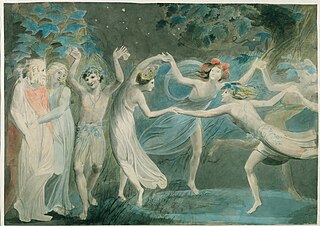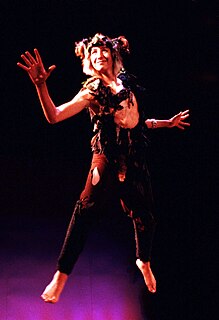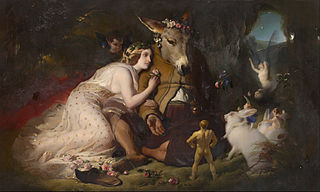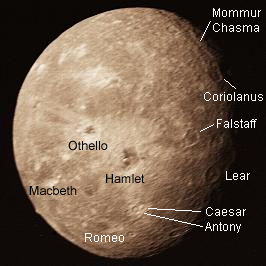Related Research Articles

A Midsummer Night's Dream is a comedy written by William Shakespeare in 1595/96. The play is set in Athens and consists of several subplots that revolve around the marriage of Theseus and Hippolyta. One subplot involves a conflict between four Athenian lovers. Another follows a group of six amateur actors rehearsing the play which they are to perform before the wedding. Both groups find themselves in a forest inhabited by fairies who manipulate the humans and are engaged in their own domestic intrigue. The play is one of Shakespeare's most popular and is widely performed.
In English folklore, Puck, sometimes known as Robin Goodfellow, is a domestic and nature sprite, demon, or fairy.

Puck, or Robin Goodfellow, is a character in William Shakespeare's play, A Midsummer Night's Dream.

Oberon, also designated Uranus IV, is the outermost major moon of the planet Uranus. It is the second-largest and second most massive of the Uranian moons, and the ninth most massive moon in the Solar System. Discovered by William Herschel in 1787, Oberon is named after the mythical king of the fairies who appears as a character in Shakespeare's A Midsummer Night's Dream. Its orbit lies partially outside Uranus's magnetosphere.

Oberon is a king of the fairies in medieval and Renaissance literature. He is best known as a character in William Shakespeare's play A Midsummer Night's Dream, in which he is King of the Fairies and spouse of Titania, Queen of the Fairies.

A fairy ring, also known as fairy circle, elf circle, elf ring or pixie ring, is a naturally occurring ring or arc of mushrooms. They are found mainly in forested areas, but also appear in grasslands or rangelands. Fairy rings are detectable by sporocarps in rings or arcs, as well as by a necrotic zone, or a ring of dark green grass. Fungus mycelium is present in the ring or arc underneath. The rings may grow to over 10 metres (33 ft) in diameter, and they become stable over time as the fungus grows and seeks food underground.

In Breton folklore, a Korrigan is a fairy or dwarf-like spirit. The word korrigan means "small-dwarf". It is closely related to the Cornish word korrik which means gnome. The name changes according to the place. Among the other names, there are korrig, korred, korrs, kores, couril, crion,goric, kornandon, ozigan, nozigan, teuz, torrigan, viltañs, poulpikan, and paotred ar sabad.
Queen Mab is a fairy referred to in William Shakespeare's play Romeo and Juliet, where "she is the fairies' midwife." Later, she appears in other poetry and literature, and in various guises in drama and cinema. In the play, her activity is described in a famous speech by Mercutio written originally in prose and often adapted into iambic pentameter, in which she is described as a miniature creature who performs midnight pranks upon sleepers. Being driven by a team of atomies, she rides her chariot over their noses and "delivers the fancies of sleeping men." She is also described as a midwife to help sleepers "give birth" to their dreams. She may be a figure borrowed from folklore, and though she is often associated with the Irish Medb in popular culture, and has been suggested by historian Thomas Keightley to be from Habundia, a more likely origin for her name would be from Mabel and the Middle English derivative "Mabily" all from the Latin amabilis ("lovable").
Thomas Keightley was an Irish writer known for his works on mythology and folklore, particularly Fairy Mythology (1828), later reprinted as The World Guide to Gnomes, Fairies, Elves, and Other Little People.
Yumboes are supernatural beings in the mythology of the Wolof people of Senegal, West Africa. They closely resemble European fairies. The alternatively used name Bakhna Rakhna literally means good people, an interesting parallel to the Scottish fairies called Good Neighbours.

The Heinzelmännchen are a race of creatures appearing in a tale connected with the city of Cologne in Germany.

Titania is a character in William Shakespeare's 1595–1596 play A Midsummer Night's Dream. In the play, she is the queen of the fairies. Due to Shakespeare's influence, later fiction has often used the name "Titania" for fairy queen characters.
In Scottish and Northern English folklore, a shellycoat is a type of bogeyman that haunts rivers and streams.

A Midsummer Night's Dream is a 1999 romantic comedy fantasy film based on the play A Midsummer Night's Dream by William Shakespeare. It was directed by Michael Hoffman. The ensemble cast features Kevin Kline as Bottom, Michelle Pfeiffer and Rupert Everett as Titania and Oberon, Stanley Tucci as Puck, and Calista Flockhart, Anna Friel, Christian Bale, and Dominic West as the four lovers.
Oberon, the Faery Prince was a masque written by Ben Jonson, with costumes, sets and stage effects designed by Inigo Jones, and music by Alfonso Ferrabosco and Robert Johnson. Oberon saw the introduction to English Renaissance theatre of scenic techniques that became standard for dramatic productions through the coming centuries.

King Goldemar is a dwarf or kobold from Germanic mythology and folklore. By the Middle Ages, Goldemar had become the king of the dwarfs in German belief. In the fairy tale "The Friendship of the Dwarfs", the author Villamaria depicts Goldemar as a "mighty dwarf king" with a queen and a court of dwarf nobles at his service. He has long, silver hair and beard and wears a crown and a purple mantle. In one tale, he runs away with the daughter of a human king. Fragments of an epic poem by Albrecht von Kemenaten called Goldemar survive. The poem tells of Dietrich's encounter with the dwarf king. The king also features in "Der junge König und die Schafërin" by German poet Ludwig Uhland. Goldemar's brothers, Alberich or Elberich and Elbegast, feature in other poems.
Hödekin is a kobold of German folklore. According to the legend recorded by folklorist Thomas Keightley in 1850, Hödekin always wore a felt hat down over his face; his name means "Little Hat". Hödekin lived with the Bishop of Hildesheim and was a helpful sprite.

Mommur Chasma is the largest 'canyon' on the known part of the surface of Uranus' moon Oberon. This feature probably formed during crustal extension at the early stages of moon's evolution, when the interior of Oberon expanded and its ice crust cracked as a result. The canyon is an example of graben or scarp produced by normal fault(s). The chasma was first imaged by Voyager 2 spacecraft in January 1986.

The Fairy Queen or Queen of the Fairies is a figure from Irish and British folklore, believed to rule the fairies. Based on Shakespeare's influence, in English-speaking cultures she is often named Titania or Mab.

The Quarrel of Oberon and Titania is an oil on canvas painting by the Scottish artist Sir Joseph Noel Paton. Painted in 1849, it depicts the scene from William Shakespeare's comedy play A Midsummer Night's Dream, when the fairy queen Titania and fairy king Oberon quarrel; Oberon was considered the King of the fairies in medieval and Renaissance literature. When exhibited in Edinburgh during 1850, it was declared as the "painting of the season". It was acquired by the National Gallery of Scotland in 1897, having initially been bought by the Royal Association for Promoting the Fine Arts in Scotland during 1850. An earlier version of this painting was Paton's diploma picture, which was submitted to the Royal Scottish Academy in 1846; they paid £700 for it.
References
- ↑ Thomas Keightley, The Fairy Mythology: Illustrative of the Romance and Superstition of Various Countries, London, Bohn, 1850; Forgotten Books, 2007; p. 42.
- ↑ Keightley, p. 57.
- ↑ Alfred Trubner Nutt, Fairy Mythology of Shakespeare, London, 1900.
- ↑ Joseph Ritson, Fairy Mythology of Shakespeare, London, Kerslake, 1875.
| This fictional location article is a stub. You can help Wikipedia by expanding it. |